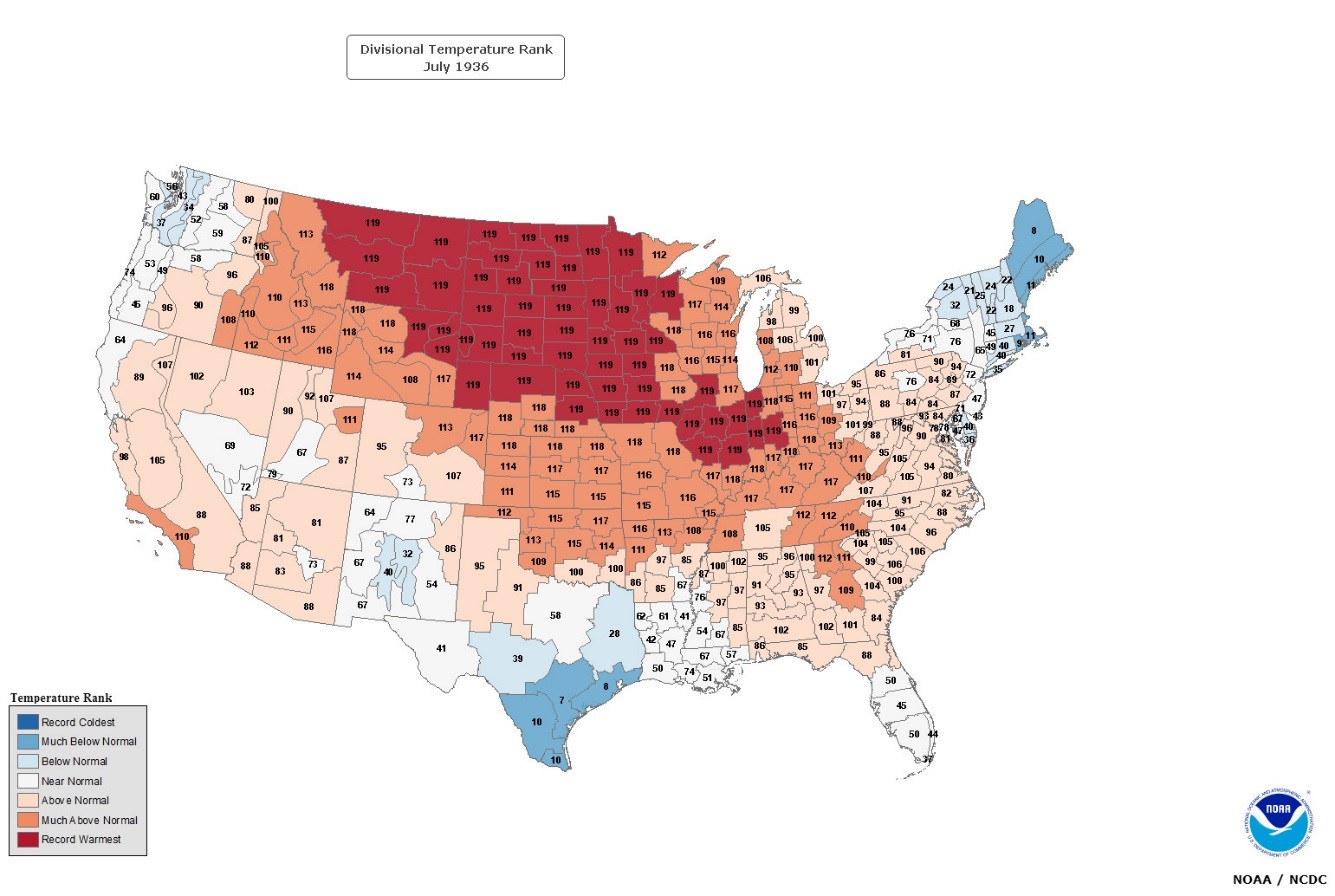Overview
The "Dust Bowl" years of 1930-36 brought some of the hottest summers on record to the United States, especially across the Plains, Upper Midwest and Great Lake States. For the Upper Mississippi River Valley, the first few weeks of July 1936 provided the hottest temperatures of that period, including many all-time record highs (see tab below).
The string of hot, dry days was also deadly. Nationally, around 5000 deaths were associated with the heat wave.
In La Crosse, WI, there were 14 consecutive days (July 5th-18th) where the high temperature was 90 degrees or greater, and 9 days that were at or above 100°F. Six record July temperatures set during this time still stand, including the hottest day on record with 108°F on the 14th. The average high temperature for La Crosse during this stretch of extreme heat was 101°F, and the mean temperature for the month finished at 79.5°F - 2nd highest on record.
Several factors led to the deadly heat of July 1936:
As a result of the "Dust Bowl", new farming methods and techniques were developed, along with a focus on soil conservation. This has helped to avert or minimize the impact of a prolonged drought.
Graphics & Maps:
 |
 |
 |
 |
| Climate region temperature ranks for July 1936 (Source: NOAA/NWS) |
1936 Temperature Rankings (Source: NOAA/NWS) |
1936 Precipitation Rankings (Source: NOAA/NWS) |
Daily Weather Map (valid July 14, 1936) |
Temperatures July 5-11, 1936
| Location | July 5 | July 6 | July 7 | July 8 | July 9 | July 10 | July 11 |
| Decorah, IA | 101°F | 106°F | 104°F | 101°F | 104°F | 103°F | 107°F |
| New Hampton, IA | 106°F | 104°F | 102°F | 100°F | 100°F | 104°F | 104°F |
| Rochester, MN | 92°F | 105°F | 102°F | 99°F | 101°F | 105°F | 104°F |
| Grand Meadow, MN | 93°F | 104°F | 100°F | 97°F | 98°F | 103°F | 102°F |
| Mondovi, WI | 90°F | M | 100°F | 101°F | 95°F | 92°F | 106°F |
| Richland Center, WI | 93°F | 100°F | 102°F | 100°F | 101°F | 103°F | 105°F |
| Hatfield, WI | 87°F | 95°F | 103°F | 100°F | 102°F | 100°F | 104°F |
| La Crosse, WI | 94°F | 100°F | 104°F | 102°F | 102°F | 100°F | 104°F |
| Lancaster, WI | 98°F | 101°F | 103°F | 100°F | 101°F | 102°F | 105°F |
| Viroqua, WI | 95°F | 100°F | 102°F | 102°F | 99°F | 98°F | 104°F |
| Mather, WI | 88°F | 90°F | 97°F | 101°F | 100°F | 102°F | 101°F |
| Medford, WI | 84°F | 89°F | 100°F | 97°F | 98°F | 94°F | 100°F |
Temperatures July 12-18, 1936
| Location | July 12 | July 13 | July 14 | July 15 | July 16 | July 17 | July 18 |
| Decorah, IA | 101°F | 109°F | 111°F | 102°F | 103°F | 106°F | 100°F |
| New Hampton, IA | 108°F | 110°F | 110°F | 106°F | 106°F | 104°F | 100°F |
| Rochester, MN | 107°F | 107°F | 108°F | 100°F | 101°F | 102°F | 96°F |
| Grand Meadow, MN | 105°F | 105°F | 106°F | 97°F | 100°F | 101°F | 96°F |
| Mondovi, WI | 109°F | 109°F | 110°F | M | M | 100°F | 100°F |
| Richland Center, WI | 108°F | 109°F | 110°F | 102°F | 97°F | 101°F | 94°F |
| Hatfield, WI | 105°F | 107°F | 108°F | 106°F | 97°F | 96°F | 98°F |
| La Crosse, WI | 105°F | 106°F | 108°F | 95°F | 97°F | 101°F | 96°F |
| Lancaster, WI | 106°F | 107°F | 108°F | 99°F | 98°F | 100°F | 84°F |
| Viroqua, WI | 106°F | 108°F | 108°F | 105°F | 96°F | 100°F | M |
| Mather, WI | 100°F | 105°F | 106°F | 106°F | 98°F | 97°F | 98°F |
| Medford, WI | 103°F | 104°F | 104°F | 92°F | 96°F | 90°F | 92°F |
All-Time Records Set in July 1936
| Location | Temperature | Date |
| Decorah, IA | 111°F | July 14 |
| Fayette, IA | 110°F | July 14 |
| New Hampton, IA | 110°F | July 13 |
| Mondovi, WI | 110°F | July 14 |
| Richland Center, WI | 110°F | July 14 |
| Rochester, MN | 108°F | July 11 & 14 |
| La Crosse, WI | 108°F | July 14 |
| Lancaster, WI | 108°F | July 14 |
| Viroqua, WI | 108°F | July 13 |
| Hatfield, WI | 108°F | July 14 |
| Osage, IA | 107°F | July 14 |
| Friendship, WI | 106°F | July 14 |
| Grand Meadow, MN | 106°F | July 14 |
| Mather, WI | 106°F | July 14 |
| Neillsville, WI | 106°F | July 14 |
| Sparta, WI | 106°F | July 13 |
| Medford, WI | 104°F | July 13 |
 |
Media use of NWS Web News Stories is encouraged! Please acknowledge the NWS as the source of any news information accessed from this site. |
 |